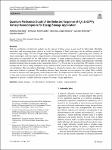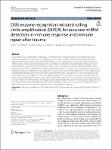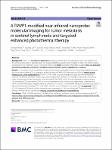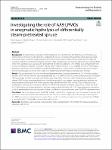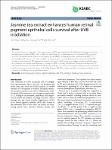Search
Author
- Carlos, Alegría (2)
- Carlos, Seara (2)
- David, Orden (2)
- Klaus, Bretterbauer (2)
- next >
Subject
Date issued
Has File(s)
- true (287)
Search Results
With the proliferation of electronic gadgets and the internet of things comes a great need for lightweight, affordable, sustainable, and long-lasting power devices to combat the depletion of fossil fuel energy and the pollution produced by chemical energy storage. The use of high-energy-density polymer/ceramic composites is generating more curiosity for future technologies, and they require a high dielectric constant and breakdown strength. Electric percolation and Interface polarization are responsible for the high dielectric constant. To create composite dielectrics, high-conductivity ceramic particles are combined with polymers to improve the dielectric constant. In this work, ternary nanocomposites with better dielectric characteristics are created using a nanohybrid filler of V... |
Recent studies have reported that miRNA plays an important role in immune response and immune repair after trauma. By regulating the expression of related target genes, miRNA regulates the production, proliferation, development and immune response of immune cells. Therefore, it is in urgent demand to develop an novel method for miRNA analysis. Rolling circle amplification (RCA), as an attractive isothermal signal amplification strategy, has been widely utilized in constructing miRNA detection assays. However, accurate and sensitive miRNA quantitative determination remains a huge challenge for RCA based approaches. Herein, we propose a DSN enzyme based signal cycle initiated Rolling Circle Amplification assay (DiRCA) for sensitive and accurate miRNA detection. In DiRCA, target miRNA ... |
TMVP1 is a novel tumor targeting polypeptide screened by our laboratory with a core sequence of five amino acids LARGR. It specially binds to vascular endothelial growth factor receptor-3 (VEGFR-3), which is mainly expressed on neo-lymphatic vessels in sentinel lymph node (SLN) with tumor metastasis in adults. Here, we prepared a targeted nanoprobe using TMVP1-modified nanomaterials for tumor metastasis SLN imaging. |
Bamboo (Dendrocalamus giganteus) is a functionally graded material with well-organized hierarchical structures. Its micrometer-sized vascular bundles and parenchymatic living cells allow an efficient upward flow of water and nutrients, endowing the organism with remarkably fast growth. As demonstrated recently, the hollow microstructure channels can be explored as a natural template for microfluidics applications in chemical synthesis, analytical detection, solar steam generation, and electrochemical devices. Thus, the knowledge of the kinetics of the imbibition and spatial distribution of fluid through the microcavities of the bamboo vegetal tissue became of interest. Here, we employed a combination of X-ray microtomography (µCT) and proton time-domain NMR (TD-NMR) to identify, mea... |
To realize the full potential of softwood-based forest biorefineries, the bottlenecks of enzymatic saccharification of softwood need to be better understood. Here, we investigated the potential of lytic polysaccharide monooxygenases (LPMO9s) in softwood saccharification. Norway spruce was steam-pretreated at three different severities, leading to varying hemicellulose retention, lignin condensation, and cellulose ultrastructure. Hydrolyzability of the three substrates was assessed after pretreatment and after an additional knife-milling step, comparing the efficiency of cellulolytic Celluclast + Novozym 188 and LPMO-containing Cellic CTec2 cocktails. The role of Thermoascus aurantiacus TaLPMO9 in saccharification was assessed through time-course analysis of sugar release and accumul... |
To examine the protecting effect of jasmine tea extract (JTE) against ultraviolet B (UVB) induced damage on human retinal pigment epithelial (RPE) cells, the RPE cells were subjected to UVB exposure and sequential JTE administration. The cell viability, intracellular reactive oxygen species (ROS), and apoptosis were determined by MTT, 2ʹ,7ʹ-dichlorodihydrofluorescein diacetate and flow cytometer assays, respectively. Further, the cells treated with UVB irradiation and sequential JTE administration were subjected to RNA-sequencing analysis in order to identify genes and pathways involved in the UVB-induced damage and JTE protecting mechanisms. |
Fluorescence-based materials that are affordable and easy to use for commercial anti-counterfeiting applications are in high demand. While exploring new fluorescent pigments, a pyrene-naphthalimide Schiff base, 5-hydroxy-2-((pyren-1-ylmethylene)amino)-1H-benzo[de]isoquinoline-1,3(2H)-dione (NHPY) with yellow fluorescence under UV light was synthesized. An eco-friendly flexographic ink prepared with NHPY as the pigment was coated on a UV dull paper and further printed on security paper as well as packaging papers and boards. When exposed to UV light, the printed samples showed yellow fluorescence. The light fastness, gloss, colorimetric results, and abrasion resistance of the printed samples proved that NHPY is a suitable fluorescent pigment for security printing applications. |

